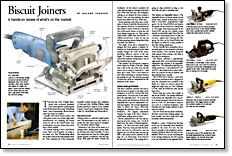Biscuit Joiners
A hands-on review of what's on the market
Synopsis: Roland Johnson assesses eight corded biscuit joiners to see how they compare. He evaluates them for fences, adjustability, noise, how well the biscuits fit, how simple the switches and slot depth setters are to use, whether sides glide and whether they have dust collection. He rates his favorites by how well they did in his tests and then by price.
The year was 1956. Dwight Elsenhower was re-elected president; Don Larsen pitched a perfect game in the World Series; Elvis sang “Heartbreak Hotel.” And in Switzerland, the first biscuit joiner was made by Lamello.
Lamello still makes biscuit joiners, also called plate joiners, but at least eight other manufacturers are cranking out biscuit joiners for sale in the United States. And woodworkers can now choose from more than a dozen models.
For anyone looking to buy a new biscuit joiner, that’s a lot of options. In trying to sort them out, Fine Woodworking asked me to take a look at the most popular models. They included all of the commonly available corded versions: the Craftsman 277300 and 17501, DeWalt DW682, Freud JS100A and JS102, Jepson 7204, Lamello Classic C2 and Top 20, Makita 3901, PorterCable 557, Ryobi JM80 and Virutex AB11C.
How joiners work
A biscuit joiner is a relatively simple power tool. The motor spins a 4-in.-dia. cutter—a toothy disc that could easily be mistaken for a shrunken tablesaw blade.
Mounted to the front of the motor is a spring-loaded, sliding guide system made up of a base and a fence assembly. To cut a slot, simply butt the front face of the guide system against a workpiece, start the machine, then push the motor toward the workpiece. As the motor is pushed, the cutter slips through an opening in the front face of the base and into the workpiece, cutting an arc-shaped slot that accepts a biscuit. Once you stop pushing, the cutter moves back behind the face of the base.
As the spinning cutter slices into a workpiece, it wants to push the biscuit joiner in the opposite direction. So manufacturers have added a variety of devices to the front face of the guide system to keep the tool from sliding during the cut. They include metal points, rubber dots and abrasive- or rubber-covered faces. I don’t see any one of these gripping systems being better than the others. Just different.
The depth of the slot is adjusted by a plunger that butts against a stepped, indexed turret. Repositioning the turret index quickly changes the travel of the cutter, providing effective control of the slot depth. To make the adjustments easier, each of the indexes corresponds to one of the standard biscuit sizes.
The Lamello Top 20 even has a means to micro-adjust the height of the slot. Simply turn a dial on the top of the tool, and the cutter can be raised or lowered in mm steps, up to 2mm. That’s a nice feature to have when switching to veneered stock in the middle of a job. The dial lets you raise or lower the cutter to compensate for the thickness of the veneer.
From Fine Woodworking #151
For the full article, download the PDF below:
Fine Woodworking Recommended Products

Pfiel Chip Carving Knife

Marking knife: Hock Double-Bevel Violin Knife, 3/4 in.

Freud Super Dado Saw Blade Set 8" x 5/8" Bore





















Log in or create an account to post a comment.
Sign up Log in